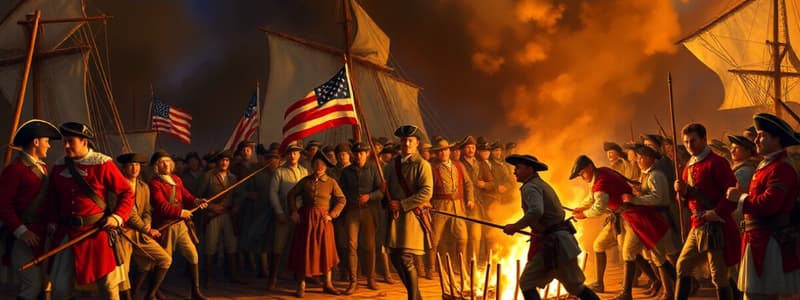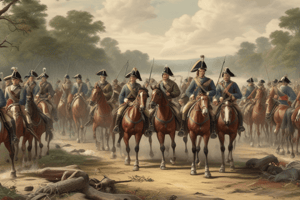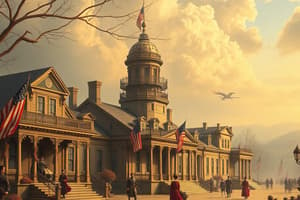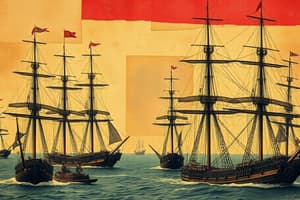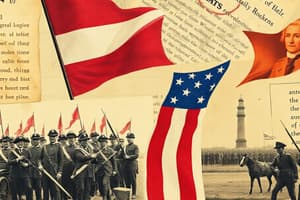Podcast
Questions and Answers
Which of the following actions by Mary Ludwig Hays McCauley, also known as Molly Pitcher, BEST exemplifies resourcefulness and determination during the Battle of Monmouth?
Which of the following actions by Mary Ludwig Hays McCauley, also known as Molly Pitcher, BEST exemplifies resourcefulness and determination during the Battle of Monmouth?
- Refusing to leave the battlefield and taking her wounded husband's place loading cannons. (correct)
- Organizing a group of local women to cook and deliver meals to the Continental Army.
- Providing emotional support to wounded soldiers by reading them letters from home.
- Negotiating with British forces for a temporary cease-fire to allow for the evacuation of the wounded.
Why did the British shift their military focus to the Southern colonies during the Revolutionary War?
Why did the British shift their military focus to the Southern colonies during the Revolutionary War?
- The Southern colonies provided better access to vital natural resources needed for shipbuilding.
- The change in strategy was due to overestimation of the terrain and underestimation of the American forces.
- The British believed they could exploit pro-British sentiments and resources more effectively in the South. (correct)
- They wanted to establish a naval blockade along the extensive coastline and disrupt American trade.
In what way did the Treaty of Paris MOST significantly shape the geopolitical landscape of North America?
In what way did the Treaty of Paris MOST significantly shape the geopolitical landscape of North America?
- It formally recognized the United States as an independent nation and defined its initial borders. (correct)
- It solidified France's control over the Mississippi River and access to the Gulf of Mexico.
- It established a clear demarcation between British Canada and the newly formed United States, setting the stage for future conflicts.
- It granted Spain control over Florida and territories west of the Mississippi River, limiting American expansion.
How did the Northwest Ordinance of 1787 MOST effectively address the issue of westward expansion while preventing future conflicts?
How did the Northwest Ordinance of 1787 MOST effectively address the issue of westward expansion while preventing future conflicts?
How were Native American tribes MOST impacted by the westward expansion following the Revolutionary War?
How were Native American tribes MOST impacted by the westward expansion following the Revolutionary War?
In what way did the actions of Benedict Arnold MOST fundamentally challenge the ideals and unity of the American Revolution?
In what way did the actions of Benedict Arnold MOST fundamentally challenge the ideals and unity of the American Revolution?
What was the MOST significant implication of the American victory at the Battle of Cowpens in January 1781?
What was the MOST significant implication of the American victory at the Battle of Cowpens in January 1781?
How did Nathan Hale's actions and famous last words MOST directly contribute to the American cause during the Revolutionary War?
How did Nathan Hale's actions and famous last words MOST directly contribute to the American cause during the Revolutionary War?
What was the MOST enduring effect of the Declaration of Independence on the institution of slavery in the United States?
What was the MOST enduring effect of the Declaration of Independence on the institution of slavery in the United States?
Which statement BEST explains the strategic importance of the Battle of Yorktown in 1781?
Which statement BEST explains the strategic importance of the Battle of Yorktown in 1781?
Following the Revolutionary War, why did Congress decide to compensate soldiers with land grants instead of monetary payments?
Following the Revolutionary War, why did Congress decide to compensate soldiers with land grants instead of monetary payments?
Which factor MOST influenced the decision by Michikinikwa (Little Turtle) and other Native American leaders to accept the Treaty of Greenville in 1795?
Which factor MOST influenced the decision by Michikinikwa (Little Turtle) and other Native American leaders to accept the Treaty of Greenville in 1795?
What action taken by John Paul Jones during a naval battle BEST demonstrates his bravery and determination?
What action taken by John Paul Jones during a naval battle BEST demonstrates his bravery and determination?
What was the MOST significant difference between state constitutions written after 1776 and the Declaration of Independence regarding civil rights?
What was the MOST significant difference between state constitutions written after 1776 and the Declaration of Independence regarding civil rights?
Which of the following served as the MOST pressing challenge to the newly formed United States government following the Revolutionary War?
Which of the following served as the MOST pressing challenge to the newly formed United States government following the Revolutionary War?
Flashcards
Civilians
Civilians
People who are not in the military.
Nathan Hale
Nathan Hale
An American spy who was caught and hanged by the British. He famously said, "I regret that I have but one life to lose for my country."
John Paul Jones
John Paul Jones
American navy commander who famously said, "I have not yet begun to fight."
Mary Ludwig Hays McCauley
Mary Ludwig Hays McCauley
Signup and view all the flashcards
Tadeusz Kosciuszko
Tadeusz Kosciuszko
Signup and view all the flashcards
Benedict Arnold
Benedict Arnold
Signup and view all the flashcards
Traitor
Traitor
Signup and view all the flashcards
Nathanael Greene
Nathanael Greene
Signup and view all the flashcards
Charles Cornwallis
Charles Cornwallis
Signup and view all the flashcards
Battle of Yorktown
Battle of Yorktown
Signup and view all the flashcards
Treaty of Paris (1783)
Treaty of Paris (1783)
Signup and view all the flashcards
State Constitutions (1776)
State Constitutions (1776)
Signup and view all the flashcards
Abolitionist
Abolitionist
Signup and view all the flashcards
Northwest Ordinance
Northwest Ordinance
Signup and view all the flashcards
Territory
Territory
Signup and view all the flashcards
Study Notes
Revolutionary Heroes
- Civilians, or people not in the military, aided the Continental Army and Navy during the Revolutionary War.
- Nathan Hale, an American spy and teacher in New York City, was hanged by the British.
- Hale's legendary last words were: "I regret that I have but one life to lose for my country."
- John Paul Jones, an American navy commander, fought larger British ships.
- During one battle at sea near Britain, Jones refused to surrender, saying, "I have not yet begun to fight," and ultimately won.
- Mary Ludwig Hays McCauley, known as Molly Pitcher, became famous for bringing water to American troops at the Battle of Monmouth in 1778.
- When her husband was wounded, McCauley took his place loading cannons in battle.
- Word of the fight for freedom spread, leading to more volunteers.
- Tadeusz Kosciuszko left Poland to serve in the Continental Army.
- Kosciuszko helped design plans for a fort at West Point, New York, now part of the United States Military Academy.
Britain Moves War to the South
- The British moved fighting to the South after learning the French were helping the Americans.
- The British had already captured several cities in the North.
- They hoped to defeat the Americans in the South before French assistance arrived.
- The British believed that many Loyalists lived in the South and would help them.
- They also aimed to capture Southern ports for supplies from British navy ships.
- Inland fighting proved more difficult for the British.
- The British lost several frontier battles, including Vincennes, in present-day Indiana.
- Savannah, Georgia, was the first British target in the South, with 3,500 British soldiers landing to attack American defenders on November 25, 1778.
- In 1780, the British captured Charles Town (Charleston) in South Carolina, where Americans were outnumbered.
- Benedict Arnold, a former Continental Army officer, became a traitor and led British attacks on Virginia towns in 1781, motivated by perceived unfair treatment by the Army.
- General Nathanael Greene led the Continental Army in the South and encouraged his soldiers to persevere.
Victory at Cowpens
- General Daniel Morgan led the Americans to a major victory at Cowpens, South Carolina, in January 1781 proving American forces could defeat the British there.
- The British army moved into North Carolina and fought at Guilford Courthouse in March 1781.
- The British held the field at Guilford Courthouse, but were weakened by the battle where both lost many soldiers.
The War Ends
- By the summer of 1781, British General Charles Cornwallis established headquarters in Yorktown, Virginia.
- Yorktown's location on Chesapeake Bay was advantageous for supplies, but also susceptible to encirclement.
- The French and Americans planned to surround Cornwallis at Yorktown.
- Both French and American soldiers marched south to encircle Yorktown.
- The French navy took control of the Chesapeake Bay, trapping General Cornwallis.
- Cornwallis surrendered on October 19, 1781, after being surrounded for weeks.
- After Yorktown there were still small battles until April 1782 when the sides met in Paris to negotiate peace.
- American negotiators John Jay, Benjamin Franklin, and John Adams sought British recognition of American independence and the removal of British soldiers from American lands.
- The Treaty of Paris was signed on September 3, 1783, which officially ended the war.
- The Treaty of Paris named the United States of America as a new nation and established its new borders.
New Ideas
- By 1776, states began writing their own constitutions, with Virginia's constitution as one model.
- Virginia's constitution began with a list of basic freedoms, including trial by jury, freedom to hold elections, and freedom of the press.
- The Declaration of Independence changed some Americans' views on people's rights, stating each person has the right to life and liberty.
- However, state constitutions didn't extend this freedom to all, with women and most African Americans not receiving the same rights as men.
Attempts to End Slavery
- In 1775, Quakers in Philadelphia formed the country's first abolitionist group.
- Antislavery sentiments increased after the Declaration of Independence.
- Elizabeth Freeman, an enslaved woman in Massachusetts, sued for freedom based on the Declaration’s assertion that all people are born equal, and won her case.
- In 1783, Massachusetts abolished slavery.
- Over time, other northern states also abolished slavery.
Western Settlements
- After the Revolutionary War, the United States lacked funds to pay all its soldiers in currency.
- The U.S. Congress compensated some soldiers with land instead, using land won from the British.
- Soldiers received land based on rank and time served, some receiving hundreds of acres west of the Appalachians.
- Many former soldiers moved west.
- Others moved west of the Appalachians to start farms.
- Congress sold large amounts of land to settlers and land companies, raising money.
- The United States stretched west to the Mississippi River, still with British troops in some northwest forts.
- Spain also had claims along the country's western and southern borders.
- Many Native American groups lived along the Ohio River.
- Lands south of the Ohio River were fast-growing, with over 100,000 people moving to the area that later became Kentucky or Tennessee during the American Revolution.
- The Northwest Territory was the land north of the Ohio River.
- A territory is land belonging to a nation but isn't a state and lacks national government representation.
Governing the Land
- Initially, no plan existed for dividing land in the Northwest Territory, so it was hard to tell where each property ended.
- In 1785, Congress passed a land ordinance, outlining how the land would be measured, divided, and sold.
- Land was divided into townships, then into 36 smaller squares, or sections.
- In 1787, Congress passed the Northwest Ordinance of 1787, which established a plan for governing the area to the north and forming new states from its lands.
- Once a region had more than 60,000 people, it could become a state.
- The ordinance guaranteed settlers freedom of religion and prohibited slavery in states formed from the territory.
Native American Battles for Land
- Following the Revolutionary War, the British left many of their western forts, making it harder for Native Americans to stop settlers from moving onto their lands.
- Native Americans in the Northwest Territory united to fight against the settlers.
- Their leaders included Michikinikwa (Little Turtle), a member of the Miami tribe.
- In the early 1790s, Native American forces soundly defeated United States soldiers in battles in what are now the states of Indiana and Ohio.
- However, in 1794, a larger United States military force won a decisive victory at the Battle of Fallen Timbers, near modern-day Toledo, Ohio.
- In 1795, Michikinikwa and other tribal leaders agreed to the Treaty of Greenville, ceding most of their land in the Northwest Territory.
- Many Native Americans resented the United States' land demands and lost trust in the government after signing the treaty.
- Some Native Americans sold land to companies like the Holland Land Company wanting land in western New York.
- Seneca leader Segoyewatha (Red Jacket) advised his tribe against the deal.
- Other leaders ignored him and signed the Big Tree Treaty, allowing the company to buy most of the Seneca's land.
- Settlers moved farther and farther in future years.
Studying That Suits You
Use AI to generate personalized quizzes and flashcards to suit your learning preferences.
